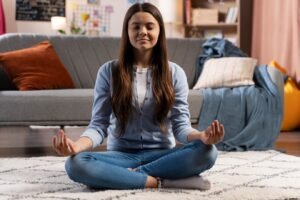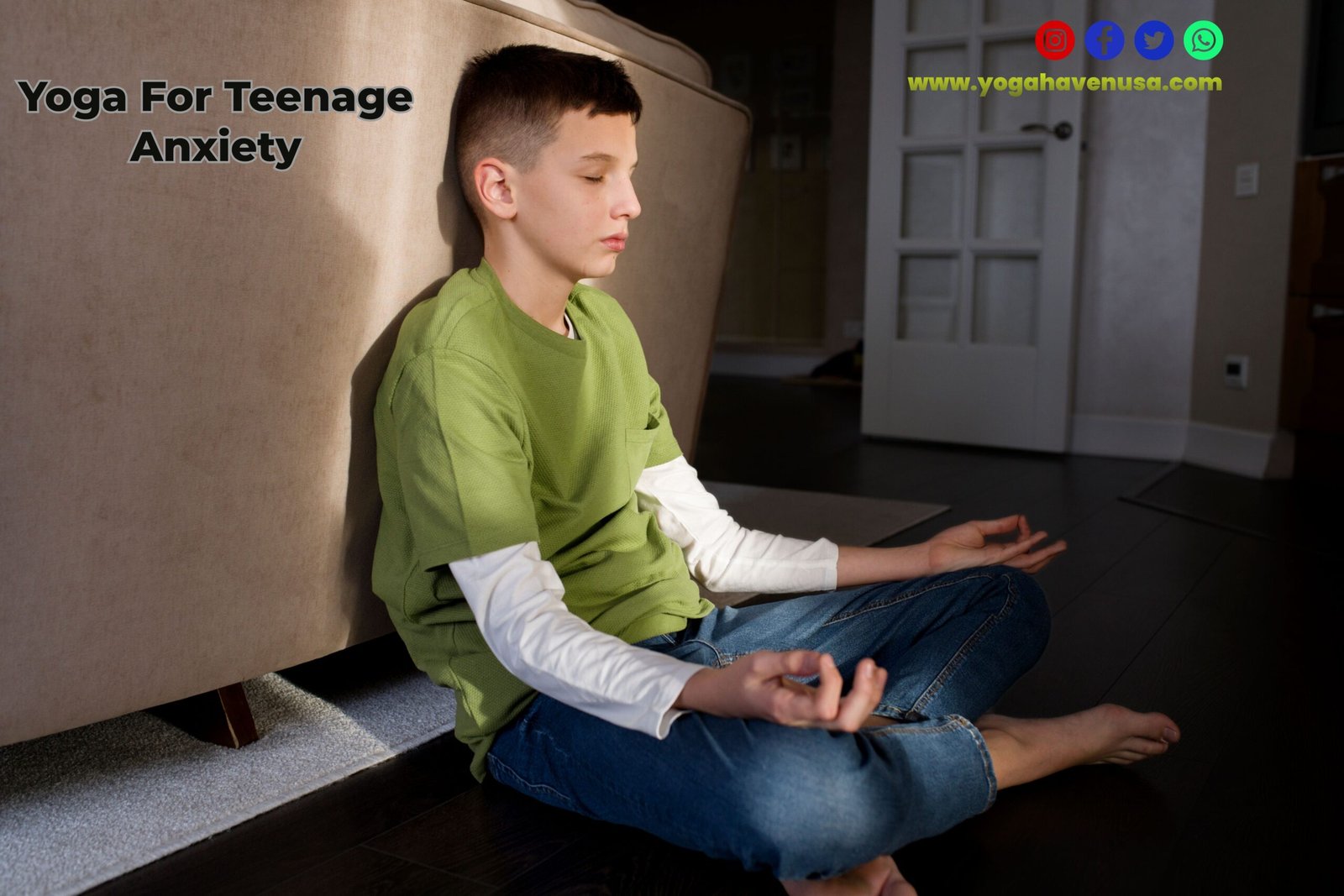Introduction
Anxiety is common in teenagers. They face stress from school, friends, and social media. Yoga can help. It’s a simple and effective way to reduce anxiety naturally. In this article, we’ll explore how yoga works for teenage anxiety.
Understanding Teenage Anxiety
Teenagers experience anxiety for many reasons. Academic pressure, peer influence, and changes in their body can all contribute. Some teens may also deal with anxiety disorders. These make daily life feel overwhelming. Yoga for teenage anxiety can offer relief. It helps both the mind and body relax.
How Yoga Reduces Anxiety
Yoga focuses on breathing and movement. This combination calms the nervous system. Breathing exercises in yoga, known as pranayama, teach teens how to control their breath. This reduces feelings of panic and helps them stay calm.
Additionally, yoga postures, or asanas, promote physical relaxation. When teens move their bodies in specific ways, tension in their muscles eases. This physical release can lead to mental relaxation. Many teens find that yoga becomes a safe space to release anxiety.
Benefits of Yoga for Teenage Anxiety
- Stress Relief
Yoga offers immediate stress relief. After a long day at school, a simple yoga routine can help teens unwind. The stretching and breathing exercises slow their heart rate and relax their muscles. - Improved Sleep
Teens with anxiety often struggle to sleep. Yoga can improve sleep quality. Certain poses, like forward bends or child’s pose, encourage relaxation. Deep breathing also helps prepare the mind for rest.

- Increased Focus
Anxiety makes it hard to concentrate. Yoga teaches mindfulness, which increases focus. Teens learn to stay present, which can help with schoolwork and other tasks. - Better Emotional Regulation
Yoga helps teens understand their emotions. Through yoga, teens can process feelings of anxiety without judgment. They become more aware of their thoughts and emotions. This awareness helps them react to stress in healthier ways.
Simple Yoga Poses for Teenage Anxiety
Yoga for teenage anxiety doesn’t have to be complicated. Here are some simple poses that can help.
- Child’s Pose
This pose calms the mind and reduces stress. It’s a gentle stretch that relaxes the back and neck. To do this pose, kneel on the floor, sit back on your heels, and stretch your arms forward. Rest your forehead on the mat. - Cat-Cow Pose
Cat-cow is great for easing tension in the back and neck. Start on your hands and knees. Arch your back toward the ceiling (cat), then drop your belly down and lift your head (cow). Move slowly between the two poses, syncing your breath. - Legs Up the Wall
This pose is perfect for calming the nervous system. Lie on your back and raise your legs up against a wall. This simple pose promotes relaxation and helps with sleep. - Corpse Pose
Corpse pose is a final resting pose that helps with deep relaxation. Lie on your back with your arms at your sides. Close your eyes and focus on your breath. Stay in this pose for several minutes to fully relax.

Incorporating Yoga into Daily Life
Yoga doesn’t require a lot of time. Even 10-15 minutes of daily practice can make a difference. For teens dealing with anxiety, it’s important to create a consistent routine. Practicing yoga every day, even for a short time, helps build healthy coping habits.
Teens can try practicing yoga in the morning to start the day with calm energy. Alternatively, they can use yoga before bed to wind down. Another option is to take breaks during the day for short yoga sessions. These breaks can help manage anxiety in stressful situations.
Yoga and Breathing Techniques
In addition to physical poses, breathing exercises are key in yoga for teenage anxiety. Breathing exercises help slow the heart rate and calm the mind. One simple technique is deep belly breathing. Here’s how to do it:
- Sit or lie in a comfortable position.
- Place one hand on your belly and the other on your chest.
- Take a deep breath in through your nose, allowing your belly to rise.
- Exhale slowly through your mouth, feeling your belly lower.
- Repeat for several breaths.
This technique can be used anytime teens feel anxious. It’s a quick and easy way to calm nerves.
How Yoga Helps Build Confidence
Anxiety often affects self-esteem. Yoga helps teens build confidence by encouraging them to focus on what their bodies can do. Instead of competing with others, yoga promotes self-awareness and self-compassion. Each teen can go at their own pace and adapt poses to fit their needs.
Over time, as teens get better at yoga, they may feel a sense of achievement. This boost in confidence can help reduce anxiety in other areas of life.
Yoga Classes for Teens
Many yoga studios offer classes specifically for teenagers. These classes are designed to meet the unique needs of teens. They focus on reducing anxiety, improving focus, and building confidence. Teens may also enjoy practicing yoga with others. Group classes provide a supportive environment where they can relax and connect with peers.
If a yoga studio isn’t an option, teens can follow yoga videos online. There are many free resources available that focus on yoga for teenage anxiety. Practicing at home is convenient and allows teens to go at their own pace.
The Long-Term Benefits of Yoga
Yoga for teenage anxiety doesn’t just provide short-term relief. With consistent practice, the benefits can last long into adulthood. Yoga teaches teens valuable skills, like mindfulness and emotional regulation, that they can use throughout their lives.
As teens continue to practice, they may find that their anxiety becomes more manageable. They may experience fewer anxiety attacks and feel more in control of their emotions. This lasting impact makes yoga a powerful tool for mental health.
Conclusion
Yoga for teenage anxiety is a natural and effective solution. By incorporating yoga into their daily routine, teens can manage anxiety in a healthy way. The combination of physical movement and deep breathing offers both immediate and long-term relief. Whether through simple poses or mindful breathing, yoga helps teens cope with the challenges of adolescence. With regular practice, they can reduce anxiety and build a foundation for emotional well-being.
